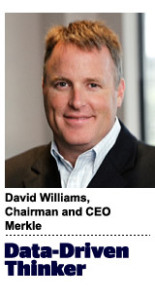 “Data-Driven Thinking” is written by members of the media community and contains fresh ideas on the digital revolution in media.
“Data-Driven Thinking” is written by members of the media community and contains fresh ideas on the digital revolution in media.
Today’s column is written by David Williams, chairman and CEO at Merkle.
The world of addressable media continues to gain scale and momentum. Every day, new addressable audience platforms, such as Apple, Amazon and Walmart, join Facebook and Google in enabling content-rich, individually personalized experiences.
Even where true person-based marketing is not yet possible, great advances in programmatic, audience-based media continue to develop in digital media and television. First- and third-party audience platforms are enabling not just targeting but delivery of immersive, highly branded content, such as native and video, across devices.
This means the traditional separation between right-brain and left-brain thinking about brand vs. performance falls away, making way for a more powerful, integrated approach focused on delivering an addressable experience.
This new way of thinking focuses on the targeting and delivery of relevant, branded experiences to the individual consumer, vertically integrated throughout the buying cycle. This concept has been around for some time, but addressability at scale through the platforms is now bringing it to life, driving competitive advantage.
The ‘Cinched Belt’ Phenomenon
Historically, even in direct-response-focused industries, budgets have been heavily concentrated on the upper and lower parts of the funnel. One insurance advertiser I know spends more than $700 million in media, with more than 70% of that budget going into top-of-funnel tactics, such as television, print, sponsorships and guaranteed display. This advertiser also spends more than $200 million a year at the very bottom of the funnel on things like branded search, aggregators, e-commerce and call-center experience.
All told, this advertiser spends less than 15% of its combined consumer budget in the mid-funnel, where consumers actually consider, engage with and decide which products they will buy from which brand.
I call this the “cinched belt” phenomenon. Spending is fat at the top and bottom but cinched tight in the middle, and the cause of the problem is not a lack of desire to spend more in this area. This insurance marketer would love to find a way to productively spend another $100 million in the mid-funnel.
A New Approach
Until recently, lack of addressability was the primary obstacle to spending in the mid-funnel. Once broad awareness and share of voice were established, little could be done to engage with individual consumers as they moved through consideration and into decision. Direct mail was used to target individuals who we believed were in-market, but that medium is now in decline. Email and display were used to relentlessly and impersonally re-target, with diminishing returns. Once these tactics were maxed out, marketers were out of ideas for how to stay engaged with consumers through the buying process. So they saved their dollars to really unload on the consumer once they typed the brand name into Google or appeared on the site.
Enter the addressable experience. Now the advertiser can drive more targeted, timely interactions with the consumer through the key moments of the cycle. A single consumer can be engaged with an individually targeted message in the Facebook newsfeed, receive a personalized offer on the landing page, get re-marketed with a relevant search ad and receive follow-up marketing with an outbound call – all with a singular brand voice and highly engaging content. This has just been moved to the top of the advertiser’s priority list.
Expand The Mid-Funnel’s Boundaries
If marketers define the mid-funnel as the space between mass media awareness and the e-commerce transaction, that definition must now expand dramatically, eating into the traditional boundaries of the upper and lower funnels.
In the upper funnel, fewer dollars will be allocated to untargeted messaging through things like national television, and more will be allocated to addressable, programmatic tactics meant to drive consideration through relevance, such as addressable TV and programmatic video.
At the bottom end, things like A/B testing and offer optimization will get pulled up into the mid-funnel as these tactics are integrated into the rest of the addressable experience. In essence, addressable and accountable spending has won most of the budget, which is what most advertisers have been seeking. That insurance marketer can now let that belt out several notches, and overall return on ad spend has increased.
Re-Visit The Supply Chain
This shift will drive greater returns but will require some fundamental changes to organizations and external supply chains. The expansion of the mid-funnel boundaries requires re-organization of internal functions for most marketers. “Brand” functions that own domain over certain media like display and social from direct marketing organizations no longer make sense. Organization around media (having separate owners for search, email and display) should be questioned.
Similarly, external marketing supply chains with disconnected components where multiple tech platforms and agencies attempt to deliver the integrated mid-funnel in silos will create complexity and insurmountable barriers to the addressable experience. Consolidating the supply chain to fewer, more vertically integrated suppliers and platforms will become the norm.
Follow David Williams (@merkle_david), Merkle (@merkleCRM) and AdExchanger (@adexchanger) on Twitter.













